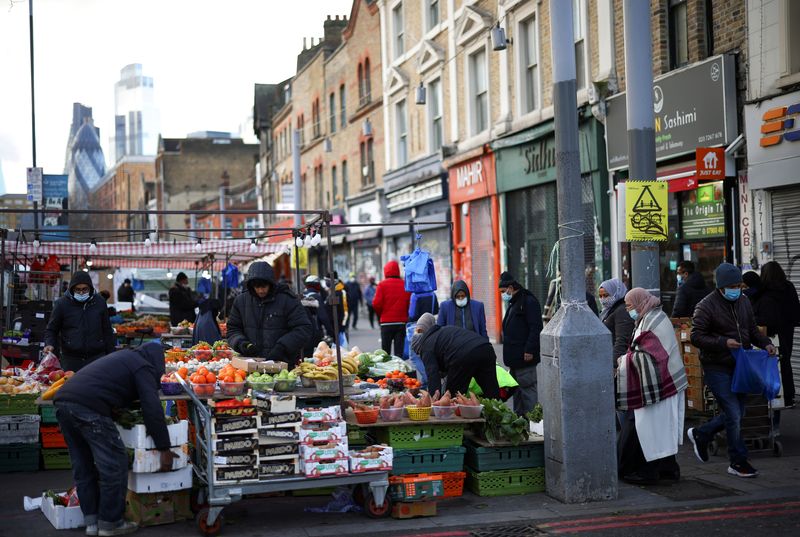
© Reuters. FILE PHOTO: People shop at a market stalls in east London, Britain, January 23, 2021. REUTERS/Henry Nicholls
By Andy Bruce and David Milliken
LONDON (Reuters) – Britain now has western Europe’s highest rate of consumer price inflation after it fell by less than expected in March to 10.1% from February’s 10.4%, official data showed on Wednesday.
Economists polled by Reuters had forecast that the annual CPI rate would drop to 9.8% in March, moving further away from October’s 41-year high of 11.1% but still eating into the spending power of workers whose pay is rising by less.
Despite falling in March, Britain’s inflation rate was the highest in western Europe and the only country in the region to post a double-digit number for last month, after Austria recorded a higher inflation rate in February.
(GRAPHIC-Britain now has Western Europe’s highest inflation rate –
The data are likely to bolster bets that the Bank of England will again raise interest rates next month after core inflation – which strips out volatile energy and food prices – failed to fall as expected in March and instead held at 6.2%.
“These figures reaffirm exactly why we must continue with our efforts to drive down inflation so we can ease pressure on families and businesses,” finance minister Jeremy Hunt said.
The Office for National Statistics said the price of food and non-alcoholic drinks rose by 19.1% in annual terms in March – the biggest such increase since August 1977.
Last month the BoE said it expected inflation to “fall significantly” in the second quarter. In February, the BoE had forecast March inflation of 9.2%.
“Another 25 basis point rate hike appears highly likely in May, and the Bank must stand ready to take further action unless economic data shows more definitive signs of cooling,” said Hugh Gimber, global market strategist at J.P. Morgan Asset Management.
While inflation is likely to drop naturally as the sharp increases in energy prices seen last year fall out of the annual comparison, the BoE is trying to judge how fast it will decline.
Other indicators have looked mixed on that front, with data on Tuesday showing stronger-than-expected wage growth. Business surveys however show cooling cost and selling price pressure.
Financial markets on Tuesday pointed to a 95% chance that the BoE will raise interest rates next month, up from 85% on Tuesday.
Inflation in prices charged by manufacturers fell sharply in March to its lowest since October 2021 at 8.7%, down from 11.9% in February, largely reflecting a drop in oil prices.
Raw material costs for manufacturers were 7.6% higher than a year earlier – down from February’s 12.8% but less of a drop than economists polled by Reuters had been expecting.





